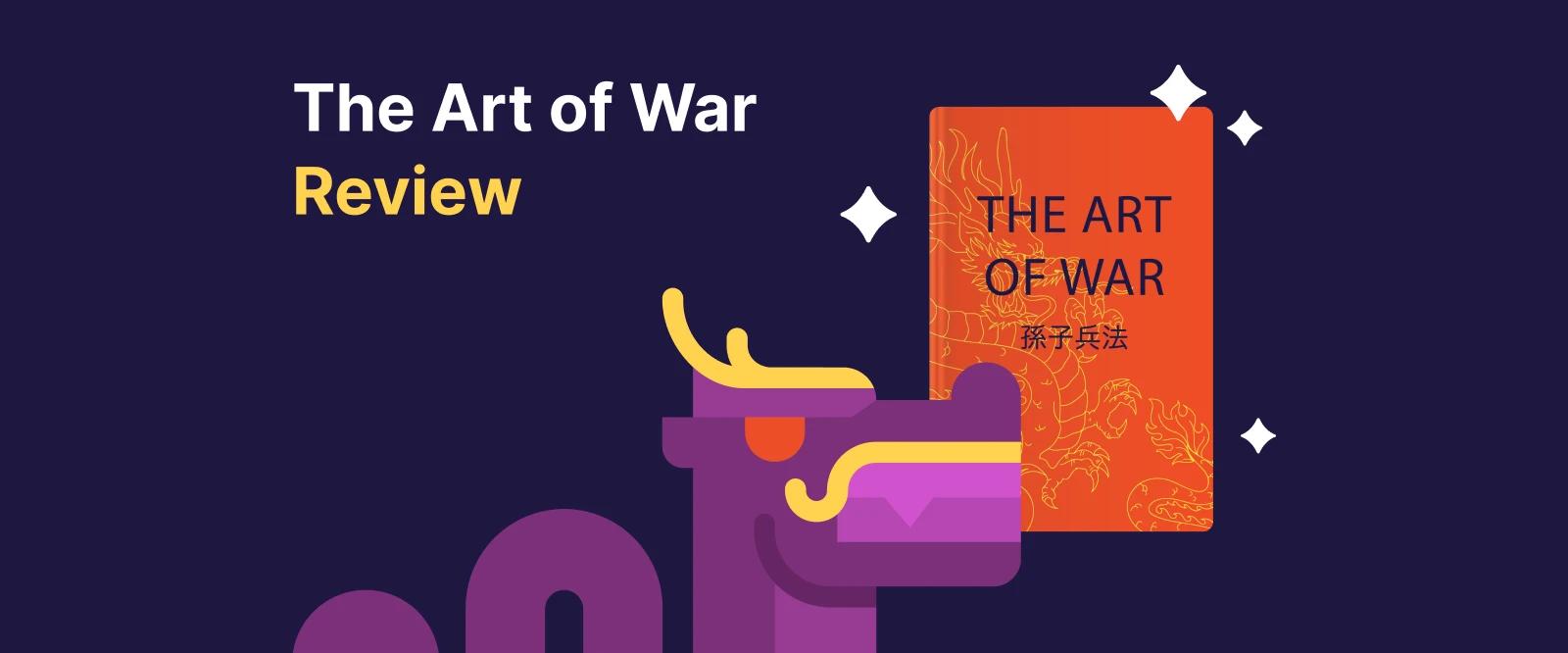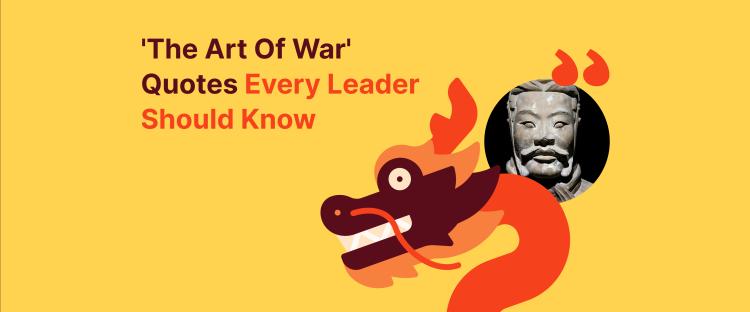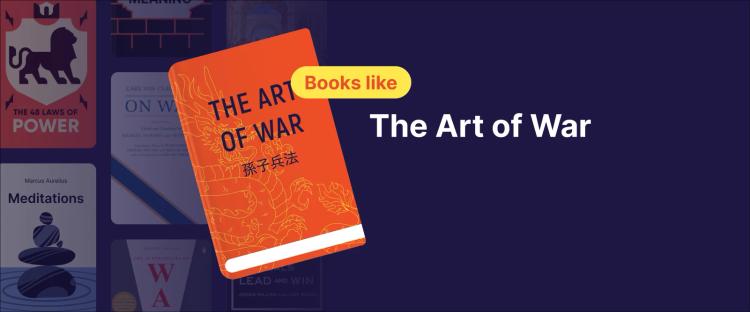'The Art of War' is an ancient Chinese military treatise by Sun Tzu that explores strategic thinking, leadership, and conflict resolution. It can be your guide in many different contexts — whether you're running a company, leading a project, or navigating personal challenges, 'The Art of War' remains a timeless guide. This review shows why Sun Tzu's leadership principles still matter today.
In this article, we are diving into a book review for a classic must-read — 'The Art of War' by Sun Tzu. As we explore the depth behind the Chinese general's ancient wisdom, we'll see how a Chinese military treatise written in the 5th century BC still shapes modern thinking across industries and cultures.
TL;DR — 'The Art of War' Summary
A timeless strategy manual by Sun Tzu, 'The Art of War,' offers lessons in leadership, conflict resolution, and strategic thinking. From knowing your enemy to winning without fighting, its teachings are used in military, business, and personal situations even today.
What is Sun Tzu's 'The Art of War' About?
'The Art of War' is one of the oldest and most influential texts on military strategy ever written. Composed in ancient China over 2,500 years ago, it is a concise but profound manual on strategy and tactics. It emphasizes intelligence, adaptability, and psychological insight over brute force.
The book is divided into 13 chapters, each focusing on a different aspect of warfare — covering everything from strategic planning to the importance of terrain, espionage, and leadership. Chapter one, 'Laying Plans,' isn't just the opening act — it lays the groundwork for everything that follows.
The book is built on the idea of mastering strategy to avoid disorder
As Sun Tzu reminds us, those who master military strategy can "fight and conquer in a hundred battles" without ever falling into disorder.'The Art of War' explores versatile principles that go far beyond warfare
The brilliance of 'The Art of War' lies in its versatility. While originally intended as guidance for war strategies, its principles can be adapted to countless areas of life, including business strategy, negotiation, personal development, and even politics.Sun Tzu suggests focusing on strategy over force
Sun Tzu's main idea is that victory is achieved not through direct confrontation, but through superior planning, understanding, and positioning. Rather than glorifying war, 'The Art of War' advocates for the subtle, mental elements of conflict, favoring strategy, deception, and flexibility over aggression and force. Its teachings emphasize knowing oneself and the enemy, mastering timing, and exploiting weaknesses — timeless lessons for competitive arenas of all kinds.
Who was Sun Tzu?
Sun Tzu, also known as Master Sun or Sunzi, was a Chinese military general, strategist, and philosopher who lived during the Eastern Zhou period (roughly around the 5th century BC). Though historical records about him are sparse and occasionally disputed, he is traditionally credited as the author of 'The Art of War.' He served under King Helü of Wu, where he demonstrated his strategic skills on the battlefield and in court, sharing his teachings with the military leaders of his time.

Sun Tzu's brilliance lay in his ability to combine military tactics with philosophical principles. He viewed conflict not just as physical combat but as a mental and moral challenge. His emphasis on discipline, flexibility, and the avoidance of unnecessary confrontation reflected a profound understanding of both the chaos and the structure of warfare.
Key lessons from 'The Art of War'
Human conflict, be it in war, business, sports, or personal disputes, hasn't changed at its core. While the tools have evolved, the principles of strategy, timing, and insight remain constant. Sun Tzu's wisdom has been embraced by leaders from Napoleon to General MacArthur, by CEOs and sports coaches, and by anyone navigating the unpredictable terrain of human interaction.
If you're looking to internalize these lessons quickly, the Headway app breaks down Sun Tzu's insights into digestible, actionable ideas. You can also find summaries of other mindset-driven books like 'Thinking, Fast and Slow' by Daniel Kahneman and 'Deep Work' by Cal Newport to deepen your strategic thinking.
But for now, here are seven powerful takeaways from 'The Art of War':
"Know yourself and know your enemy." The foundation of all strategy is understanding your own capabilities and weaknesses, as well as those of your opponent. Self-awareness, human nature, and research are non-negotiables in any competition.
"The supreme art of war is to subdue the enemy without fighting." True victory is achieved through influence, diplomacy, and foresight. The best generals win before the first blow is struck.
Adaptability is your greatest weapon. Like water taking the shape of its container, you must adjust your strategy based on shifting circumstances. Rigidity invites defeat.
Deception is a strategic tool. "All warfare is based on deception." Manipulating perception, sowing confusion, and keeping your true intentions hidden can shift the balance in your favor.
Speed and timing matter. Sun Tzu advocates for quick, decisive action when the moment is right. Hesitation can be as fatal as miscalculation.
Victory comes from preparation. Success is often a product of planning rather than execution. Anticipate the enemy's moves, prepare for contingencies, and ensure readiness.
Choose battles wisely. Engagement should only happen under favorable conditions. Sun Tzu believed that knowing when not to fight is just as crucial as knowing how to fight.
How can you use 'The Art of War' in business, life, and personal growth?
'The Art of War' by Sun Tzu isn't just about military tactics — it's a timeless manual for strategic thinking in everyday life. Its lessons apply to business, personal development, and even daily decision-making.
This Chinese military treatise, revered for its wisdom, remains one of the most profound works ever written on war. Yet its true power lies in how its lessons transcend the battlefield and influence modern strategy, echoing the pragmatic insights of thinkers like Machiavelli.
Today, its strategic depth finds surprising relevance not only in military command but also across boardrooms, personal development journeys, and the rhythms of everyday life.
Want more strategic thinking for leadership? Headway's summary of 'The 48 Laws of Power' offers complementary ideas for decision-making, persuasion, and navigating office politics.
1. How to apply 'The Art of War' in business and leadership
Modern business strategy often mirrors the competitive dynamics of warfare. CEOs, managers, and entrepreneurs use Sun Tzu's principles to:
Outperform rivals
Create winning market strategies
Lead teams effectively
Understanding competitors, mastering timing in product launches, and anticipating market trends are all tactics deeply rooted in this classic text.
For example, Apple's launch of the iPhone was a textbook case of strategic timing and preparation — entering the market with a revolutionary product just as mobile technology was reaching a tipping point.
2. Sun Tzu's strategy for personal development
You don't need to wage literal wars to benefit from 'The Art of War.' This ancient Chinese work teaches:
Emotional intelligence
Patience
The ability to step back before reacting impulsively
These qualities are essential for personal growth. It acts as a self-help guide, encouraging introspection. Where are your strengths? What are your blind spots? By understanding yourself, you empower your actions with intentionality.
3. Lessons from 'The Art of War' in everyday life
You can also apply Sun Tzu's insights to:
Negotiate better outcomes
Handle conflict with empathy
Make thoughtful, strategic life decisions
Even casual situations, like a chess match or a workplace disagreement, can benefit from the book's focus on timing, restraint, and knowing your advantage.
Pros and cons of the 'The Art of the War'
A well-rounded book review of 'The Art of War' reveals not only the depth of its strategic insight but also the complexities of applying an ancient treatise to the modern world. From its philosophical elegance to the interpretive challenges posed by translation, this section takes a closer look at what makes this great book both remarkable and occasionally difficult to understand.

Pros:
Enduring relevance: A consistent highlight in any book review of 'The Art of War' is how its strategic wisdom remains applicable across modern fields, from leadership to entrepreneurship.
Philosophy in compact form: At under 100 pages, the text condenses vast concepts into concise reflections. The chapter titled 'Laying Plans' sets the tone, showing how thorough preparation can make conflict unnecessary — a lesson that transcends time.
Adaptability through translation: Numerous versions exist, and many English translations preserve the elegance and nuance of Sun Tzu's ideas, making the text accessible to a global audience.
Cons:
Abstract by design: The original work is intentionally sparse and poetic, which means that without guidance, the deeper meanings can be missed. First-time readers often benefit from annotated editions.
Varying impact based on translation: Because Sun Tzu wrote in classical Chinese, the English translation you choose can significantly shape your understanding. Some editions emphasize literal accuracy, while others lean into interpretive commentary.
Not prescriptive: Unlike modern strategy books, 'The Art of War' doesn't lay out step-by-step instructions. It offers mental frameworks rather than plug-and-play tactics, requiring the reader to bridge theory and practice on their own.
The verdict on Sun Tzu's 'The Art of War': Final thoughts
All book reviews of 'The Art of War' point to one thing: this isn't merely a guide to military conquest — it's a philosophy of mindful living and strategic thinking. Sun Tzu's wisdom urges us to step back from waging war, assess with clarity, and act with intention.
The now-famous saying "know yourself and know the enemy" captures the book's essence: self-awareness and insight are the ultimate tools of victory.
His teachings often parallel those of other Eastern philosophers, such as Lao Tzu, merging action with restraint and power with stillness. Where Lao Tzu focused on harmony and flow through the Tao, Sun Tzu is a military strategist, chartering a path toward clarity amid chaos.
Ultimately, 'The Art of War' is a mirror. It reflects how we prepare, decide, adapt, and respond. No matter the context — business, personal growth, or interpersonal relationships — it challenges us to think deeper and act smarter.
Even after more than two millennia, this military strategy book continues to captivate modern readers. On Goodreads, 'The Art of War' has over 545,000 ratings and 22,000 reviews, reflecting its widespread influence and ongoing relevance. Meanwhile, on Amazon, various editions of the book have sold millions of copies. This remarkable longevity underscores how Sun Tzu's insights still resonate in today's busy, competitive world.
Master strategy with Headway book summaries
Want to understand 'The Art of War' in just 15 minutes?
Headway's summary makes it easy to grasp Sun Tzu's timeless strategies — even if you've never read a strategy book before.
Then continue exploring our app with similar books, such as 'The Prince' by Niccolò Machiavelli, 'Meditations' by Marcus Aurelius, or Robert Greene's 'The 33 Strategies of War'.
FAQs about 'The Art of War'
Is The Art of War still relevant today?
Absolutely. Sun Tzu’s The Art of War remains influential in leadership, business, sports, and personal development. Its insights are timeless and applicable far beyond the battlefield, guiding readers in how to think strategically and act decisively.
Is The Art of War difficult to read?
It’s short but dense, with poetic and abstract language. To make it easier, many readers choose annotated editions — or pick it up on Kindle, where versions often include helpful commentary and highlights.
What's the best version to read?
The Thomas Cleary and Lionel Giles translations are both well-regarded. If you’re interested in comparing philosophies, 'The Book of Five Rings' by Miyamoto Musashi offers a similarly strategic mindset from a Japanese perspective.
What are the five rules of The Art of War?
Sun Tzu emphasizes five key factors: moral alignment, timing, terrain, leadership, and disciplined execution. These elements form the basis of tactical dispositions, helping you plan and respond with foresight in any conflict.
What are the five military strategies?
While not explicitly numbered, recurring themes include deception, speed, adaptability, preparation, and the use of stratagem to outmaneuver opponents.
Who was the best military strategist in history?
Many consider Sun Wu — another name for Sun Tzu — among the greatest, thanks to his philosophical, restrained approach that values clarity over chaos.
What do The 33 Strategies of War teach you?
Robert Greene’s book draws from military history and classic texts like The Art of War to offer actionable strategies for personal and professional situations — echoing principles from martial arts as well.
When and why was The Art of War written?
The text dates back over 2,500 years to the Warring States period in ancient China. It was written to provide military leaders with a guide for winning conflicts through intellect, adaptability, and planning rather than brute force.













